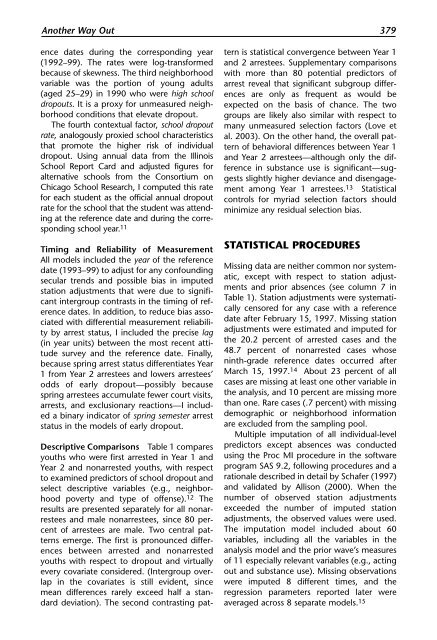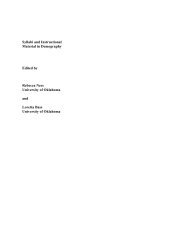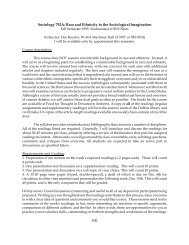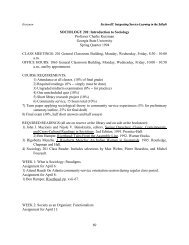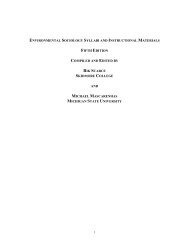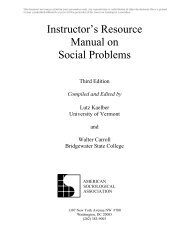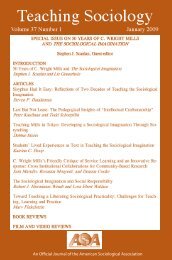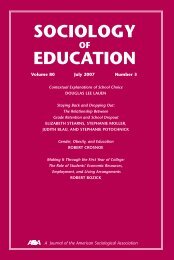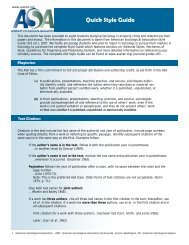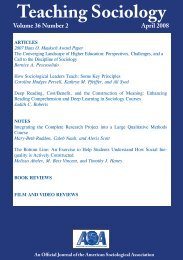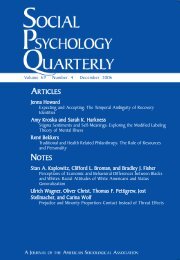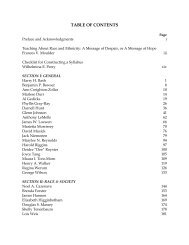SOCIOLOGY EDUCATION - American Sociological Association
SOCIOLOGY EDUCATION - American Sociological Association
SOCIOLOGY EDUCATION - American Sociological Association
Create successful ePaper yourself
Turn your PDF publications into a flip-book with our unique Google optimized e-Paper software.
Another Way Out 379<br />
ence dates during the corresponding year<br />
(1992–99). The rates were log-transformed<br />
because of skewness. The third neighborhood<br />
variable was the portion of young adults<br />
(aged 25–29) in 1990 who were high school<br />
dropouts. It is a proxy for unmeasured neighborhood<br />
conditions that elevate dropout.<br />
The fourth contextual factor, school dropout<br />
rate, analogously proxied school characteristics<br />
that promote the higher risk of individual<br />
dropout. Using annual data from the Illinois<br />
School Report Card and adjusted figures for<br />
alternative schools from the Consortium on<br />
Chicago School Research, I computed this rate<br />
for each student as the official annual dropout<br />
rate for the school that the student was attending<br />
at the reference date and during the corresponding<br />
school year. 11<br />
Timing and Reliability of Measurement<br />
All models included the year of the reference<br />
date (1993–99) to adjust for any confounding<br />
secular trends and possible bias in imputed<br />
station adjustments that were due to significant<br />
intergroup contrasts in the timing of reference<br />
dates. In addition, to reduce bias associated<br />
with differential measurement reliability<br />
by arrest status, I included the precise lag<br />
(in year units) between the most recent attitude<br />
survey and the reference date. Finally,<br />
because spring arrest status differentiates Year<br />
1 from Year 2 arrestees and lowers arrestees’<br />
odds of early dropout—possibly because<br />
spring arrestees accumulate fewer court visits,<br />
arrests, and exclusionary reactions—I included<br />
a binary indicator of spring semester arrest<br />
status in the models of early dropout.<br />
Descriptive Comparisons Table 1 compares<br />
youths who were first arrested in Year 1 and<br />
Year 2 and nonarrested youths, with respect<br />
to examined predictors of school dropout and<br />
select descriptive variables (e.g., neighborhood<br />
poverty and type of offense). 12 The<br />
results are presented separately for all nonarrestees<br />
and male nonarrestees, since 80 percent<br />
of arrestees are male. Two central patterns<br />
emerge. The first is pronounced differences<br />
between arrested and nonarrested<br />
youths with respect to dropout and virtually<br />
every covariate considered. (Intergroup overlap<br />
in the covariates is still evident, since<br />
mean differences rarely exceed half a standard<br />
deviation). The second contrasting pat-<br />
tern is statistical convergence between Year 1<br />
and 2 arrestees. Supplementary comparisons<br />
with more than 80 potential predictors of<br />
arrest reveal that significant subgroup differences<br />
are only as frequent as would be<br />
expected on the basis of chance. The two<br />
groups are likely also similar with respect to<br />
many unmeasured selection factors (Love et<br />
al. 2003). On the other hand, the overall pattern<br />
of behavioral differences between Year 1<br />
and Year 2 arrestees—although only the difference<br />
in substance use is significant—suggests<br />
slightly higher deviance and disengagement<br />
among Year 1 arrestees. 13 Statistical<br />
controls for myriad selection factors should<br />
minimize any residual selection bias.<br />
STATISTICAL PROCEDURES<br />
Missing data are neither common nor systematic,<br />
except with respect to station adjustments<br />
and prior absences (see column 7 in<br />
Table 1). Station adjustments were systematically<br />
censored for any case with a reference<br />
date after February 15, 1997. Missing station<br />
adjustments were estimated and imputed for<br />
the 20.2 percent of arrested cases and the<br />
48.7 percent of nonarrested cases whose<br />
ninth-grade reference dates occurred after<br />
March 15, 1997. 14 About 23 percent of all<br />
cases are missing at least one other variable in<br />
the analysis, and 10 percent are missing more<br />
than one. Rare cases (.7 percent) with missing<br />
demographic or neighborhood information<br />
are excluded from the sampling pool.<br />
Multiple imputation of all individual-level<br />
predictors except absences was conducted<br />
using the Proc MI procedure in the software<br />
program SAS 9.2, following procedures and a<br />
rationale described in detail by Schafer (1997)<br />
and validated by Allison (2000). When the<br />
number of observed station adjustments<br />
exceeded the number of imputed station<br />
adjustments, the observed values were used.<br />
The imputation model included about 60<br />
variables, including all the variables in the<br />
analysis model and the prior wave’s measures<br />
of 11 especially relevant variables (e.g., acting<br />
out and substance use). Missing observations<br />
were imputed 8 different times, and the<br />
regression parameters reported later were<br />
averaged across 8 separate models. 15


